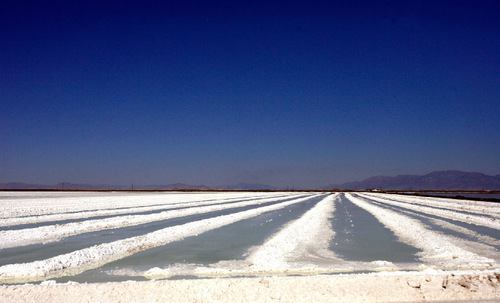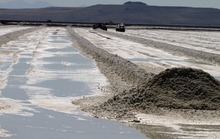This is an archived article that was published on sltrib.com in 2010, and information in the article may be outdated. It is provided only for personal research purposes and may not be reprinted.
A company that extracts potassium sulfate and other minerals from the waters of the Great Salt Lake said it is willing to scale back the pace of its expansion plans, in part to appease conservationists.
But environmental groups, worried about the effect the company's growth may have on the lake, said the new proposal does little to address their fears.
Great Salt Lake Minerals Corp., which in 2007 applied to the U.S. Army Corps of Engineers to add 91,000 acres of solar ponds to its existing 45,000-acre footprint, said Thursday it proposed an alternative plan to develop, in increments, the new ponds, rather than all at once.
"This will mean the company will be using a lot less water," said Dave Hyams, a spokesman for GSL Minerals. "And, it will also allow the company and public agencies to better monitor the lake's ecology while the development takes place."
However, Lynn de Freitas, executive director of Friends of the Great Salt Lake, said the company's new approach of "develop first and study later" may leave the lake vulnerable. "We need to make sure we understand any impacts in advance, not later when it may be too late."
But Hyams countered that any such effects will be addressed in the environmental impact statement, which the company must complete to gain regulatory approval for its requested expansion.
GSL Minerals' proposed a 91,000-acre expansion of its solar evaporation ponds is slated to be the third of a three-phase undertaking to address the growing agricultural demand for "sulfate of potassium" or SOP. It is a nonchemically-enhanced fertilizer widely used to improve crop yields.
The first phase, which saw the company invest $40 million in its plant to increase its annual potassium sulfate production by 100,000 tons, was launched in 2008 and is expected to be completed by year's end.
GSL Minerals contends it is the only SOP producer in the United States.
Under the second phase launched in late September, GSL Minerals is using newly developed "sealing" technologies at its existing ponds to reduce the amount of brine that soaks into the ground. The technology also will keep the briny waters inside its ponds from flowing too rapidly. That means more minerals can be harvested.
GSL Minerals said the new sealing technology also will be used as the new ponds are developed under phase three of the company's expansion plan. And that technology means it will only need an additional 150,000 acre feet of water rather than the 353,000 acre-feet it originally requested to take from the lake.
"This technology has been proven effective, and we're pleased that we now can introduce [it] into our overall plan to increase production while reducing the amount of water we need," Corey Milne, site manager for GSL Minerals, said in a statement.
But de Freitas argues the company already has more than enough water to meet its needs. Allowing it to take an additional 150,000 acre-feet could jeopardize water levels, she said.
"They say they simply want to keep up with market demand [for SOP], but just recently they announced efficiency measures to reduce existing water use and increase production enough to meet that demand for more than a decade without further expansion," she said.
According to GSL Minerals, SOP demand has been growing by an average of 2 percent to 3 percent annually for the past 20 years. And since late September, the company has announced two price increases that combined raised the cost of a ton of SOP by approximately 10 percent to around $550.
"The need for our all-natural sulfate of potash [potassium sulfate] is expected to rise significantly over the next five years as fruit and vegetable consumption increases," Milne said.













